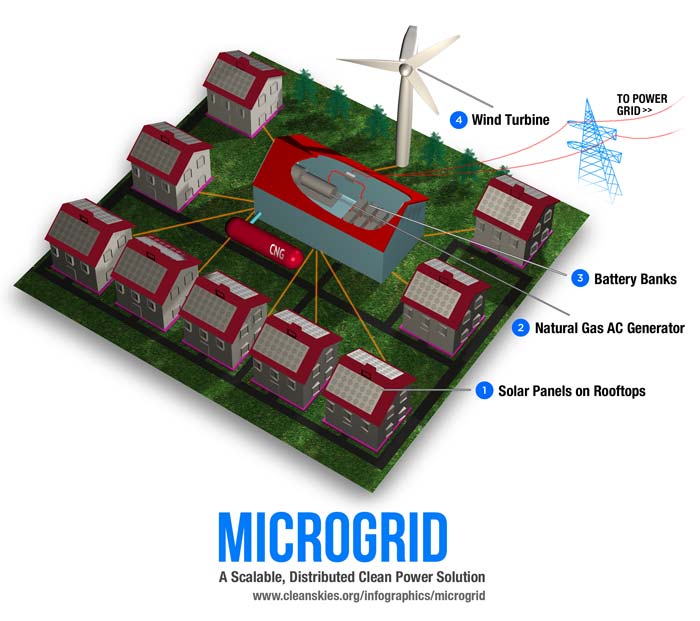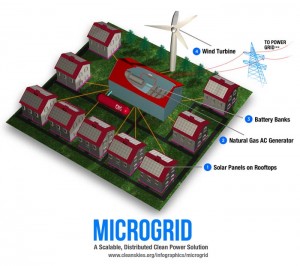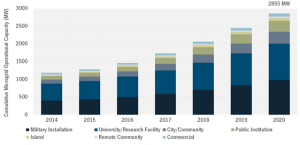
El Niño and the Case for Microgrids
This is a post from Andrew Landrum, a current Juris Doctor candidate in University of Richmond School of Law. He presents the case of Microgrids in El Niño, which could be able to generate and store electricity for use independent of the traditional national grid in such extreme weather events.
Winter is coming to the United States’ national electric grid. El Niño – an ocean temperature event that affects global weather – is on its way and is expected to be one of the strongest events in recent history. Already, we have seen El Nino’s warmer ocean currents create severe weather conditions, causing blackouts throughout the Asian and Pacific regional energy grids. Experts have expressed similar fears that such extreme weather events might spell danger for the United States’ energy grid. These and other events revive the necessary conversation regarding the resiliency of our bulk-power system. The United States should consider supporting distributed energy policies, specifically microgrids, to guard against future strains on the nation’s ageing energy infrastructure.
Securing our grid means ensuring continued and unfettered access to electricity. Threats to access continue to evolve, but can be grouped into the following categories: natural events, such as El Niño and falling tree branches; terrorist attacks, including physical or cyber attacks; and an electromagnetic pulse, potentially generated by a low-orbit detonation of a nuclear bomb, resulting in rolling blackouts foreseeably lasting for months, or even years. Weather events are likely to become more frequent as a result of climate change. And, while a terrorist attack or EMP seems like science-fiction, the threats are real enough to alarm key administrators former-Chair of the Central Intelligence Agency, Jim Woosley, and former-Chairman of the Federal Energy Regulatory Commission, John Wellinghoff.
Together, Woosley and Wellinghoff have attempted to raise awareness that any sustained blackout event could result in devastating financial losses and social instability. To substantiate such fears, the Department of Energy recently presented data concluding that regular blackouts experienced by the United States result in, on average, $18 and $23 billion in losses a year. As a solution, these administrators have proposed microgrids as a source of distributed energy – the onsite storage or generation of electricity – to protect against future interruptions.
What Are Microgrids?
Microgrids are localized distributed generation systems that are able to generate or store electricity for use independent of the traditional national grid. These local systems may be operated in a controlled way, either while connected to the main power network, or disconnected from the grid as an ‘electrical island.’ If a hurricane or other natural disaster causes a local blackout, microgrid users can disconnect and use their onsite generation or storage units to supply power and sustain operations. Common forms of microgrids include small-scale renewable energies, natural gas generators, batteries, or, theoretically, small-modular nuclear reactors. Each microgrid system is flexible to meet the end-users specific needs and can be composed of a combination of storage, renewable, and gas-supported technologies.
Figure: Microgrid Display
Source. Cleanskies.org
Microgrids offer a number of benefits in addition to grid resiliency and avoiding the detrimental economic effects of small and large-scale blackouts. First, microgrids provide a more efficient method of electricity generation. Traditionally, electricity is delivered to the end-user through an array of transmission and distribution systems that connect the customer to an offsite generator. The U.S. Energy Information Administration predicts that, on average, about 6% of electricity is lost in this process before reaching the customer. Microgrids do not have this problem, as electricity is generated onsite. Integrating microgrids, therefore, leads to fewer transmission and distribution losses over time and, therefore, less electricity needed to meet demand.
Second, microgrids increase the national grid’s flexibility in serving idiosyncratic customers, such as: remote locations, areas of high-demand, and military facilities incapable of risking loss of service. Take Hawaii for example. The average retail price of electricity in Hawaii is three times the national average. The U.S. Pacific Missile Facility Range, on the Hawaiian island of Kauai, requested assistance from the National Renewable Energy Laboratory for its power supply. Microgrid installation on military bases – both domestic and abroad – is of clear value to military planners, as bases cannot allow power outages or fossil fuel dependence to interfere with performing their necessary duties.
The American Security Project has previously discussed the advantages of the military’s microgrid and renewable energy technology investments here and here.
Modern Developments
Microgrid technology exists, but key markets are only now beginning to emerge. The Department of Defense has invested, and will continue to invest, significant resources in microgrid technologies to secure key facilities and bases against existential threats. Colleges like New York University have developed fully functional microgrids composed of natural gas generators that have proven success in weathering temporary power outages. Cities like Brooklyn, New York, have developed a fully sustainable microgrid to protect against future blackouts.
Energy regulators have also noticed microgrid’s opportunity. The FERC and regional operators have made steps to ease the integration of microgrids into our larger energy infrastructure. First, the FERC’s 2011 Order 745 targeted efficiency programs instituted to adapt to peak demand levels called demand response. The order was later challenged in court for, among other reasons, lack of jurisdiction and the United States Supreme Court is scheduled to hear the case’s oral arguments in mid-October of 2015. A decision finding the FERC capable of regulating these demand-side programs could “transform microgrids from threats to local distribution utilities into valuable resources for the larger grid.” In addition, Independent Regional Operators (ISO) and Regional Transmission Operators (RTO) – state and regional operating organizations established by the FERC to coordinate, control, and monitor the electrical power system within their jurisdiction – have created significant opportunities for microgrid development. PJM, the Mid-Atlantic grid operator, has already approached microgrid generators to discuss their energy plans. This conversation could allow microgrids to seamlessly integrate into an already-regulated demand market. In addition, New York’s ISO recently promoted a $40 million prize for community microgrid development.
These, and other, developments have created major opportunities for microgrid expansion. Such momentum was highlighted in the 2015 GMT North American Microgrid report, which projected a capacity expansion greater than 2.8 gigawatts by 2030.
Figure: U.S. Microgrid Capacity Forecast by End-User Type, Base Case
Source: North American Microgrids 2015
However, while the momentum is impressive, the microgrid industry has expressed concerns regarding its regulatory status as defined by local, state, and federal laws. As previously discussed, microgrids generate electricity similar in kind to that of a public utility, although on a much smaller scale. Public utilities are forced to comply with extensive and costly regulations imposed upon them by the FERC and other service-area states. Microgrid operators now fear that continued development might blur the line between a microgrid generator and a public utility, potentially forcing these small-scale developers to expend a significant portion of their resources to comply with state and federal regulations. Such concerns may deter future investment by developers.
These, and other fears, could be assuaged if regulators made deliberate efforts to define microgrids in the context of their surrounding regulations. Currently, very few states have made such an effort. As microgrids expand, more must be done to clarify applicable microgrid regulations and determine how states and the federal government share jurisdiction in regulating this new activity. Northeast states provide good examples for states interested in regulating and supporting microgrids. States like New York and Connecticut have set standards for some forms of microgrid generation, provided financial support for microgrid projects, and seen utilities working with customers to reach generation goals. However, many legal questions remain, including ownership and how to apply certain land-use and other public utility restrictions.
Conclusion
If the question of state and federal microgrid regulation were answered soon, the industry could better capitalize on this recent development momentum. The Clean Power Plan’s federal mandate requiring states to adapt their energy infrastructure to particular emissions goals creates significant opportunities for microgrids. Earlier this year, bipartisan legislative support for microgrids was introduced to the Senate Energy Committee as part of the 2015 Energy Policy Modernization Act – sponsored by Lisa Murkowski (R – AK) and Maria Cantwell (D – WA). With clear support for resiliency, included within the bill are provisions for grid research, grants for development, and support for demonstration microgrid projects. The bill now waits to be presented on the Senate floor for debate. In the mean time, regulators should catch up to industry momentum and clarify legal uncertainties that could otherwise derail one valuable protection against the ills associated with our nation’s ageing energy infrastructure.







